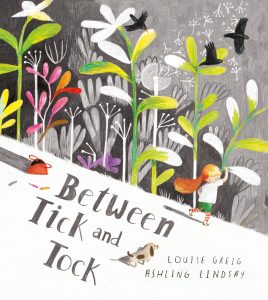 In a grey bustling city there is no time stop the roundabout to make friends, or notice a lost toy rolling under a park bench or help a stray dog or a stuck cat. But high in the rooftops where the birds roost, Liesel seems to stand outside of time and has the power to make the city pause for a moment. She uses this superpower to stop the clock between ticks and go paint a colourful mural, arrange an accidental encounter so that two children can become friends. She finds the toy and rescues the stray dog and generally intervenes to help people stop and take stock, to notice what’s going on around them. Between Tick and Tock is a meditation on how easy it is to get lost in the day to day and forget to marvel at the world. It raises philosophical questions on the nature of time.
In a grey bustling city there is no time stop the roundabout to make friends, or notice a lost toy rolling under a park bench or help a stray dog or a stuck cat. But high in the rooftops where the birds roost, Liesel seems to stand outside of time and has the power to make the city pause for a moment. She uses this superpower to stop the clock between ticks and go paint a colourful mural, arrange an accidental encounter so that two children can become friends. She finds the toy and rescues the stray dog and generally intervenes to help people stop and take stock, to notice what’s going on around them. Between Tick and Tock is a meditation on how easy it is to get lost in the day to day and forget to marvel at the world. It raises philosophical questions on the nature of time.
Is the flow of time just a human invention, something we just read on a clock?
Does it really exist?
Is time infinite? Or is there a beginning and an end to time?
What happens when the present moment becomes past?
Could it be possible to step outside of time?
Do we need time?
What does it mean to waste time?
How do you know you are in the present?
Do the past and the future exist?
Does time pass more quickly or slowly at depending on what you are doing?

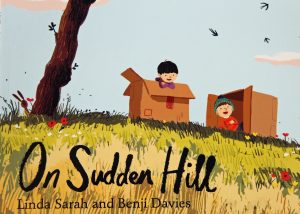 Birt and Etho are BIG friends. Playing together they let their imaginations sore and cardboard boxes become castles, yachts, rockets and space ships. Birt loves their two-by-two rhythm. Then one (cold) Monday morning a tiny boy named Shu comes along. He has been watching them play from afar and has finally plucked up the courage to ask if he can join in too – he has brought his cardboard box. Two become three, Etho welcomes Shu – but Birt feels strange …
Birt and Etho are BIG friends. Playing together they let their imaginations sore and cardboard boxes become castles, yachts, rockets and space ships. Birt loves their two-by-two rhythm. Then one (cold) Monday morning a tiny boy named Shu comes along. He has been watching them play from afar and has finally plucked up the courage to ask if he can join in too – he has brought his cardboard box. Two become three, Etho welcomes Shu – but Birt feels strange …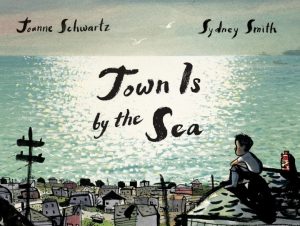 It goes like this – a boy lives with his family in a house by the sea. It’s summer and the sea is sparkling. The boy and his friend play on the only two swings that are left, there used to be four. He runs an errand for his mother. He visits his grandfather’s gravestone.
It goes like this – a boy lives with his family in a house by the sea. It’s summer and the sea is sparkling. The boy and his friend play on the only two swings that are left, there used to be four. He runs an errand for his mother. He visits his grandfather’s gravestone. 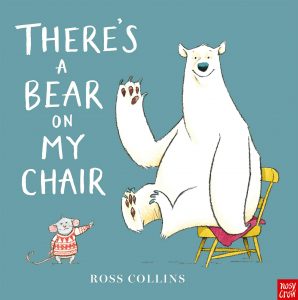 A rather large polar bear has taken up residence on a very small mouse’s chair. The mouse does everything he can think of to get the bear to move, pushing and shoving, staring him out, luring with delicious fruit… The mouse even tries frightening the bear by jumping out of a box (in his rather unsightly green underpants) to no avail. The bear won’t budge. Then the tables are turned as the bear reveals his endangered status and suddenly we become unsure of what’s right and what’s wrong.
A rather large polar bear has taken up residence on a very small mouse’s chair. The mouse does everything he can think of to get the bear to move, pushing and shoving, staring him out, luring with delicious fruit… The mouse even tries frightening the bear by jumping out of a box (in his rather unsightly green underpants) to no avail. The bear won’t budge. Then the tables are turned as the bear reveals his endangered status and suddenly we become unsure of what’s right and what’s wrong. 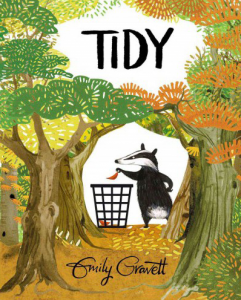 Pete the badger is obsessively tidy. It’s bad enough that his obsession encroaches on his friends personal space but then he turns his attention to cleaning up the environment… and when scrubbing and polishing rocks and picking up every single fallen autumn leaf creates a mound of plastic bags and results in the trees looking “bare and scrappy” he takes things even further. Pete’s extreme cleansing measures, as well as destroying many creatures habitat, result in him being unable to find his way home and after a hungry night spent in the bowl of a cement mixer, he finally sees his mistake. It really helps to pay close attention to the images in this story. The expression on the animals faces as Pete gives them a bath, the flower in the bin, the pile of bin bags, the hoover in the forest, the price tags on the trees…
Pete the badger is obsessively tidy. It’s bad enough that his obsession encroaches on his friends personal space but then he turns his attention to cleaning up the environment… and when scrubbing and polishing rocks and picking up every single fallen autumn leaf creates a mound of plastic bags and results in the trees looking “bare and scrappy” he takes things even further. Pete’s extreme cleansing measures, as well as destroying many creatures habitat, result in him being unable to find his way home and after a hungry night spent in the bowl of a cement mixer, he finally sees his mistake. It really helps to pay close attention to the images in this story. The expression on the animals faces as Pete gives them a bath, the flower in the bin, the pile of bin bags, the hoover in the forest, the price tags on the trees…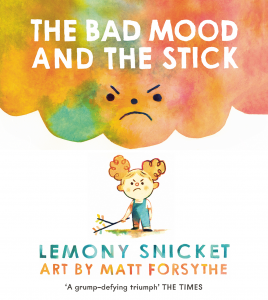 A girl named Curly is in a bad mood and happens to come across a stick which has randomly fallen to the ground. The stick comes in handy for poking her little brother and happily also relieves her of her bad mood – which has been now passed to her mum. The bad mood is passed on further and so is the stick the stick finds an unlikely home in an ice cream parlour window whose owner keeps it there because it makes him happy.
A girl named Curly is in a bad mood and happens to come across a stick which has randomly fallen to the ground. The stick comes in handy for poking her little brother and happily also relieves her of her bad mood – which has been now passed to her mum. The bad mood is passed on further and so is the stick the stick finds an unlikely home in an ice cream parlour window whose owner keeps it there because it makes him happy.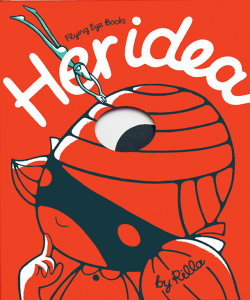 Sozi has an idea, in fact she has hundreds of ideas but they are slippery and illusive and when she comes to turn her ideas into reality she finds it’s not so easy. Then a passerby offers some hope. The passerby is a book which looks very much like the one that you are holding in your hands (more so if you remove the dust jacket). It helps capture her ideas and keep them safe until she is ready to do something with them.
Sozi has an idea, in fact she has hundreds of ideas but they are slippery and illusive and when she comes to turn her ideas into reality she finds it’s not so easy. Then a passerby offers some hope. The passerby is a book which looks very much like the one that you are holding in your hands (more so if you remove the dust jacket). It helps capture her ideas and keep them safe until she is ready to do something with them.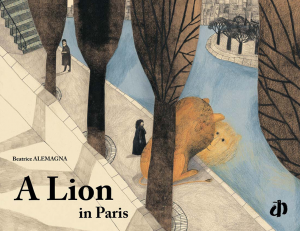 A lion, big curious and bored decides to leave the grasslands in search of something more – a job, love and a future. Arriving in Paris by train he is a little daunted by the busy city. He thinks that he might surprise the Parisians but instead they surprise him – by taking no notice. As he takes in more and more of Paris he grows to love the city and decides finally to give up his freedom and his grassland home for a plinth in the middle of a busy roundabout.
A lion, big curious and bored decides to leave the grasslands in search of something more – a job, love and a future. Arriving in Paris by train he is a little daunted by the busy city. He thinks that he might surprise the Parisians but instead they surprise him – by taking no notice. As he takes in more and more of Paris he grows to love the city and decides finally to give up his freedom and his grassland home for a plinth in the middle of a busy roundabout. Sam and Dave dig a hole next to an apple tree just outside a house. There is a cockerel weathervane on the roof and a red tulip in a pot balanced on the railing. A grey cat with a red collar watches. A dog joins Sam and Dave on their mission to dig until they find something spectacular. They dig and dig and each time they are on the brink of discovery they change direction and miss out. But something spectacular does happen and they land back where they started or do they? Sam and Dave seem unaware as they go inside for chocolate milk and animal biscuits that a few things are different.
Sam and Dave dig a hole next to an apple tree just outside a house. There is a cockerel weathervane on the roof and a red tulip in a pot balanced on the railing. A grey cat with a red collar watches. A dog joins Sam and Dave on their mission to dig until they find something spectacular. They dig and dig and each time they are on the brink of discovery they change direction and miss out. But something spectacular does happen and they land back where they started or do they? Sam and Dave seem unaware as they go inside for chocolate milk and animal biscuits that a few things are different.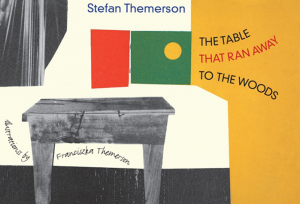 This small format picture book written in 1930’s poignantly tells the story of how the author’s writing desk puts on two pairs of shoes, (a pair belonging to him and a pair belonging to his wife) and takes off down the stairs out of a man-made urban environment and back to the woods where it takes root.
This small format picture book written in 1930’s poignantly tells the story of how the author’s writing desk puts on two pairs of shoes, (a pair belonging to him and a pair belonging to his wife) and takes off down the stairs out of a man-made urban environment and back to the woods where it takes root.